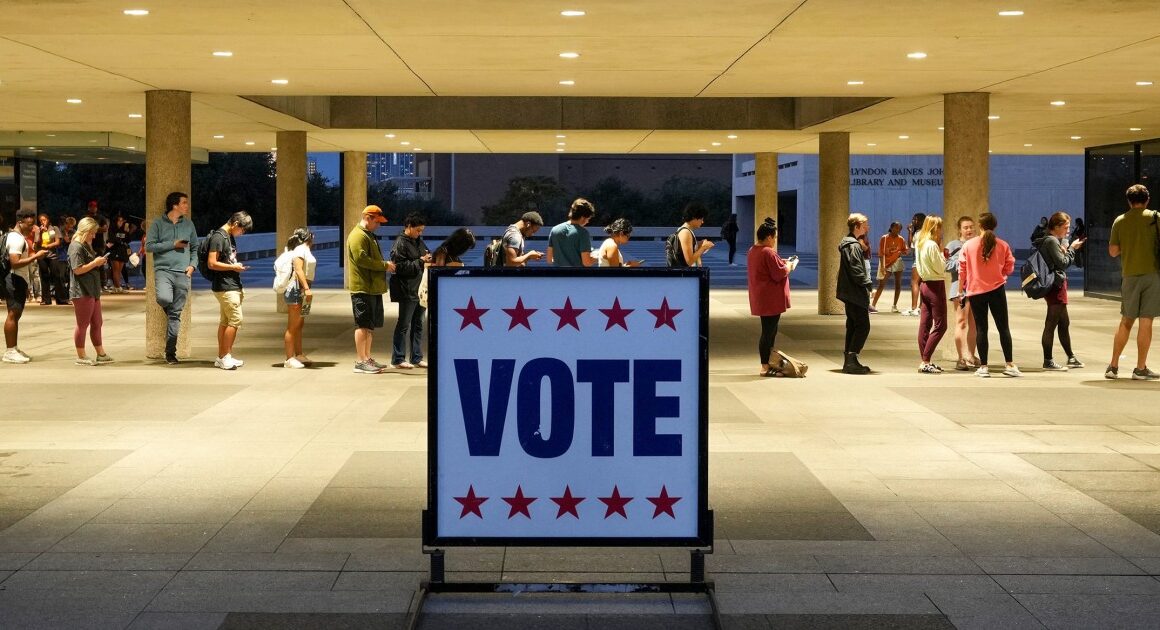WASHINGTON — In the heat of the 2024 campaign season, more than 400 first-time voters from across the country gathered here in July to discuss political issues and the upcoming election — but with a focus on being polite rather than being polarized.
The participants in “America in One Room: The Youth Vote,” an event organized by Stanford political scientists and other sponsors, included Kendall Rene Martin, who will be 18 in November, a Democrat from California; Tyler Kunkowski, 18, a Republican from Florida; Emily Criswell, 18, who leans left, from rural Tennessee; and Steven Dilts, 19, who also leans left, from Alaska.
After the four-day event, a poll of these first-time voters released on Monday found that in those four days they moved closer together on contentious issues, developed more respect of differing views and became more committed voters after the days of dialogue.
The gathering was a so-called deliberative poll where the participants were randomly selected to produce a representative sample of young voters from the entire nation. The purpose was to discuss the issues, hear from policy experts and foster a better conversation on American politics.
There have been past “America in One Room” studies of the general electorate, but this was the first to specifically examine first-time young voters.
“We are doing democracy here, and it’s actually working,” said Henry Elkus, founder and CEO of Helena, one of the gathering’s other organizers and partners. “I don’t see any ad-hominem attacks. I don’t see division in the way it’s shown on our TV screen. And I don’t see a representation of politics that the media.”
“I see actual working democracy,” Elkus added. “And this is the generation that will define that.”
The gathering took place one week after the assassination attempt on Donald Trump and in the midst of President Joe Biden’s departure from the 2024 race.
But the aim was to discuss the issues, not the candidates.
“When the candidate goes away, you have to confront the issue,” Elkus said.
‘I agree with that’: Moving closer on contentious issues
The first-time voters spent one weekend discussing issues like the environment, the economy and health care in small breakout groups. They heard from policy experts from across the ideological spectrum, toured the monuments in the nation’s capital and even attended a Major League Baseball game.
And the young voters moved closer together on several contentious issues — both from the right and left — according to results from the poll conducted before and after the gathering.
On climate and energy, for example, the share of first-time voters who believed the United States should achieve energy independence grew, from 62% before the gathering to 76% afterward.
The share of participants who opposed eliminating the sale of new gas- and diesel-powered automobiles by 2035 increased, from 45% before to 59% afterward.
And the portion of young voters who opposed drilling in the Artic wilderness increased, from 72% before to 76% afterward.
“Living in the Arctic wilderness, I am very against this,” said Steven, the young voter from Alaska, during one of the breakout sessions on the environment.
Tyler, the Republican from Florida, said he believed in climate change but voiced skepticism about the feasibility of international accords like the Paris climate agreement. He added that he would support drilling in the Arctic only in case of a national emergency like a war.
“I agree with that,” Steven replied.
At the end of the discussion, Steven remarked, “I am surprised everyone in this room agrees this is an issue,” referring to the broader topic of combatting climate change.
“It is harder to insult somebody to their face because we want to be liked. Humans are inherently good,” concluded Elkus, one of the organizers. “Online discourse, comments sections — it allows us to be inhuman.”
“This is a human process. Democracy requires human interaction. And that’s what we’re doing here,” he said.
‘I see that point’: Young voters gain more respect for differing views
The polling results also showed these young voters gaining more respect for differing viewpoints, with the share of participants saying their opponents had good reasons for their positions growing from 64% before the event to 71% afterward.
During a breakout discussion on whether to increase the minimum wage, Tyler argued that a college-educated bank worker shouldn’t earn the same wage as an employee at McDonald’s.
Emily, from rural Tennessee, disagreed: “This is not an attack on you,” she said. “Not everybody can go to college.”
Tyler countered that a college degree is an investment for future higher wages.
“I see that point,” Emily replied. “But you don’t have to go to college to be successful.”
“The people who came to ‘America in One Room’ were very well-versed in politics and all had a lot of knowledge of what they spoke about, so I valued and respected every single one of their opinions,” Tyler said in a follow-up interview with NBC News.
“To my surprise, there wasn’t a moment of hostility, despite tense discussions,” said Kendall, the Democrat from California. “Being in that environment gave me so much hope for the future of our country and inspired me to educate myself even more.”
‘I left with an even stronger passion to vote’
The before-and-after poll of the assembled young voters also showed a stronger satisfaction with American democracy.
Before the gathering, 29% said they were somewhat or very satisfied with the way in which democracy is working in the United States. That doubled to 58% after the event.
And the researchers behind the “America in One Room” deliberations also found the participants became more committed to voting, compared with a control group of young voters who didn’t attend the gathering in D.C.
“I left with an even stronger passion to vote and speak up about current and social issues,” said Kendall of California.
“They came from all over the country — red states, blue states, urban and rural,” said James Fishkin, the Stanford political scientist who pioneered these deliberative “America in One Room” experiments.
“Yet their divisions are not intractable,” he added. “And instead of triggering each other, they listened respectfully and saw the merits of what was said by those they most strongly disagreed with.”
,










